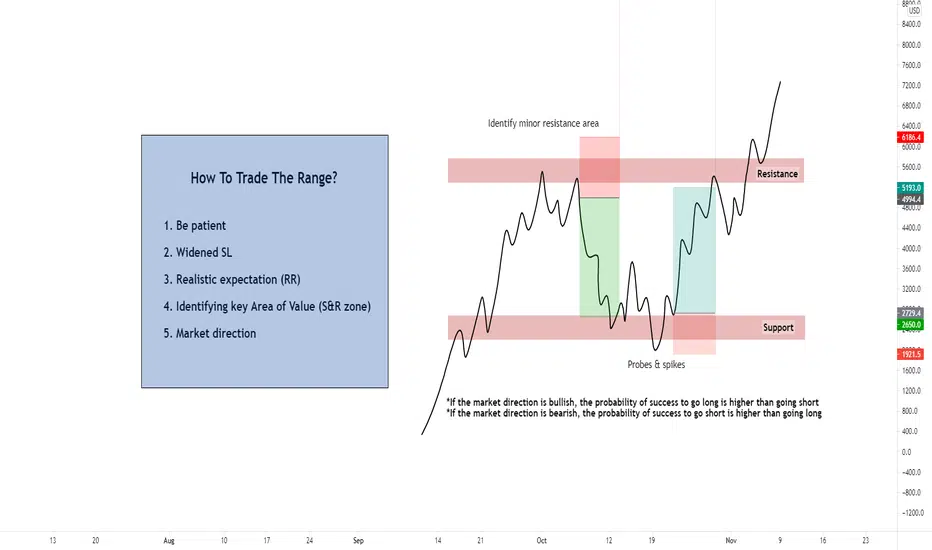Hi Traders, today's topic regarding "How to simplify range setups?" If you are someone who's constantly giving back profits during range bound condition, this post is dedicated for you. Majority of traders are able to make money during trending condition, but only to watch huge chunk of their profits peeled off during a choppy/ range bound condition. These are few of the simple steps to improve your ability to trade the range safely.
1. Be patient
2. Widened SL
*To trade the range safely, you must widen up your Stop Loss to prevent probes & spikes. Unlike any textbook range condition, a range bound condition in the live market contains plenty of fakeout. By widening your SL, it provides some cushion for your range setups to breathe and allow you to have a calm state of mind. Because once you get stopped out with a widened SL, it signals you probably the range condition is coming to an end.
3. Realistic expectation (RR)
*Majority tend to 'predict' the break rather than respect the market. Avoid having some unrealistic expectation if the market itself is presenting a tighter range. If it is a 50 pips range, by having a 100 pips target you are enforcing your personal will & expectation into the market. By doing so, you would always see some of the great range setups turning against you.
4. Identifying key Area of Value (S&R zone)
*During a range bound condition, it's vital to spot key S&R zones and ignore the minor ones. The only Area of Value for range setups area is S&R zones, if you're trading a continuation pattern (Eg. flag) within a range, most likely it might fail.
5. Market direction
*By identifying the market direction, you are improving the probability of success. Think about this logically, If the market had a prior bullish impulse, the probability of success to go long is higher, because buyers' are in control, the probability of market breaking above the range is greater too, vice versa.
Comment down below what's your worst experience trading the range!
"Trade what you see not what you think." - Warren Buffet
Trade safe as usual.
Do follow my profile for daily fx forecast & educational content.
1. Be patient
2. Widened SL
*To trade the range safely, you must widen up your Stop Loss to prevent probes & spikes. Unlike any textbook range condition, a range bound condition in the live market contains plenty of fakeout. By widening your SL, it provides some cushion for your range setups to breathe and allow you to have a calm state of mind. Because once you get stopped out with a widened SL, it signals you probably the range condition is coming to an end.
3. Realistic expectation (RR)
*Majority tend to 'predict' the break rather than respect the market. Avoid having some unrealistic expectation if the market itself is presenting a tighter range. If it is a 50 pips range, by having a 100 pips target you are enforcing your personal will & expectation into the market. By doing so, you would always see some of the great range setups turning against you.
4. Identifying key Area of Value (S&R zone)
*During a range bound condition, it's vital to spot key S&R zones and ignore the minor ones. The only Area of Value for range setups area is S&R zones, if you're trading a continuation pattern (Eg. flag) within a range, most likely it might fail.
5. Market direction
*By identifying the market direction, you are improving the probability of success. Think about this logically, If the market had a prior bullish impulse, the probability of success to go long is higher, because buyers' are in control, the probability of market breaking above the range is greater too, vice versa.
Comment down below what's your worst experience trading the range!
"Trade what you see not what you think." - Warren Buffet
Trade safe as usual.
Do follow my profile for daily fx forecast & educational content.
Disclaimer
The information and publications are not meant to be, and do not constitute, financial, investment, trading, or other types of advice or recommendations supplied or endorsed by TradingView. Read more in the Terms of Use.
Disclaimer
The information and publications are not meant to be, and do not constitute, financial, investment, trading, or other types of advice or recommendations supplied or endorsed by TradingView. Read more in the Terms of Use.
